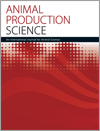
Animal Production Science
Volume 63 Number 6 2023
Tools that consider the emotional states of livestock are needed for comprehensive welfare assessment. We examined a relatively new method called the attention-bias test, finding that it may provide a practical measure of negative emotional states and trait fearfulness in sheep and other livestock species. The attention-bias test can potentially be used in further research to better understand how management practices and environments affect livestock welfare, with an ultimate aim to improve welfare outcomes on-farm.
AN22260 Abstract | AN22260 Full Text | AN22260PDF (1.2 MB) Open Access Article
AN22273Oxidative stability of milk and expression of oxidative stress response, lipogenic-related, and IGF-1 genes in early-lactation cows supplemented with peanut and sunflower oils
 , Márcia Saladini Vieira Salles, João Alberto Negrão, Antonio Leandro Chaves Gurgel
, Márcia Saladini Vieira Salles, João Alberto Negrão, Antonio Leandro Chaves Gurgel  , João Luiz Pratti Daniel, Luciano Soares de Lima, Francilaine Eloise de Marchi, Luiz Carlos Roma Júnior and Geraldo Tadeu dos Santos
, João Luiz Pratti Daniel, Luciano Soares de Lima, Francilaine Eloise de Marchi, Luiz Carlos Roma Júnior and Geraldo Tadeu dos Santos
We evaluated the effects of supplementation with peanut and sunflower oils on fatty acid profile, milk oxidative stability, and expression of oxidative stress response genes in pasture-fed Jersey cows. Peanut oil supplementation increased the health-promoting index of milk, whereas sunflower oil supplementation increased susceptibility to lipid peroxidation.
A study was conducted over 5 years at Victoria River Research Station, Northern Territory, Australia, to determine the effects of phosphorus (P) supplementation on the growth and reproductive performance of Brahman females grazing P-deficient pastures and to evaluate the return on investment in P supplementation. P supplementation resulted in large improvements in growth, pregnancy rate, weaning rate, average weaner weight, weaner production, mortality rate and gave an excellent return on investment.
The poultry industry is in need of the more effective source of selenium for improving productivity of poultry flocks in commercial set-ups. In this study, advantages and disadvantages of various selenium sources for poultry birds are analysed and future directions on the application of various maternal selenium sources for improving the productivity of broiler offspring are identified. This is significant because use of organic selenium in breeders` diets improved antioxidant status and meat quality in young broiler offspring.
Utilisation of the by-products in the animal nutrition results in less consumption of cereal grain by animals. These by-products, such as grape pomace (GP), could form an important component of ruminant diets. The GP is being produced after extracting juice that is not used by humans or industries. Results showed that GP that has been exposed and treated with Neurospora sitophila may provide a suitable supplementary feed for ruminants when incorporated into diets at rates of up to 20%.
AN22075Effect of diurnal feeding times and sources of energy supplementation to optimise rearing of F1 Angus × Nellore young bulls
 , Abmael da Silva Cardoso, Natália Vilas Boas Fonseca, Dennis P. Poppi, Luís Orlindo Tedeschi, Isabela Rita Coletti Micheletti, Willi Rocha Meireles, Ana Cláudia Ruggieri and Ricardo Andrade Reis
, Abmael da Silva Cardoso, Natália Vilas Boas Fonseca, Dennis P. Poppi, Luís Orlindo Tedeschi, Isabela Rita Coletti Micheletti, Willi Rocha Meireles, Ana Cláudia Ruggieri and Ricardo Andrade Reis
Different responses of energy supplementation to grazing beef cattle may occur due to the type of energy substrate and the supplementation time. Citrus pulp supplied in the afternoon can improve beef cattle performance. Citrus pulp can replace corn as an energy supplement and it is a non-human edible food.
AN22075 Abstract | AN22075 Full Text | AN22075PDF (2.3 MB) Open Access Article
AN22012Inclusion of guanidinoacetic acid in the diet of laying hens at late phase of feeding
 , Hítalo J. S. Barbosa
, Hítalo J. S. Barbosa  , Matheus G. Fraga, Marcela V. Triginelli, Bruno T. A. Costa, Matheus A. Ferreira, Michele O. Mendonça, Silvana V. Cançado and Leonardo J. C. Lara
, Matheus G. Fraga, Marcela V. Triginelli, Bruno T. A. Costa, Matheus A. Ferreira, Michele O. Mendonça, Silvana V. Cançado and Leonardo J. C. Lara
Fortification or enrichment is currently being employed to improve the nutritional value of livestock feeds. This work evaluated the use of guanidino acetic acid (GAA) in the feed of laying hens to increase egg creatine concentrations, and found no increase in creatine deposition.
AN22089Relationship of pig carcass grade with the amount of pork belly estimated with AutoFom III
 , Kwangwook Park, Changhyun Woo, Sanghun Park, Yun-a Kim, Gyutae Park, Sehyuk Oh, Jaeyoung Kim and Jungseok Choi
, Kwangwook Park, Changhyun Woo, Sanghun Park, Yun-a Kim, Gyutae Park, Sehyuk Oh, Jaeyoung Kim and Jungseok Choi 
The aim of this study was to investigate the relationship of the pig carcass grade system with the pork belly carcass weight and backfat thickness. The correlation coefficient did not show significance between pig carcass grade and backfat thickness. However, a significant difference was found in carcass weight. The grading system should be modified to reflect the meat quality.
AN22057Physicochemical, volatile compounds, oxidative and sensory profiles of the Longissimus muscle of six South African sheep breeds

Sheep meat production and quality is challenged by limited availability of water and feed. The current study compared the quality of meat from different sheep breeds in South Africa. Adoption of sustainable production systems will produce healthy meat desired by consumers.



